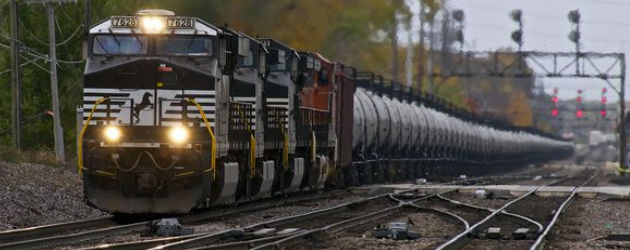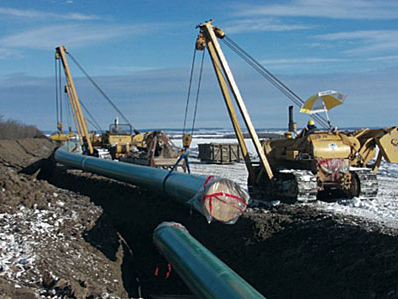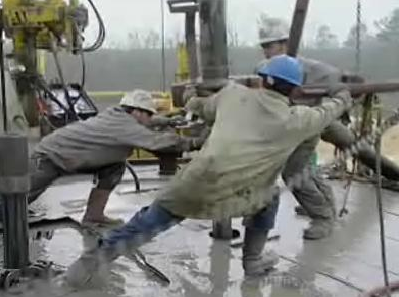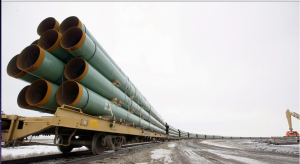Rail emerges as alternative to Keystone XL pipeline for moving oil from Canada
 Courtesy Washington Post by Steven Mufson and Juliet Eilperin: Even if foes of the Keystone XL pipeline block it, companies seeking to get Canada’s oil sands to U.S. and world markets could travel the old-fashioned way: by rail.
Courtesy Washington Post by Steven Mufson and Juliet Eilperin: Even if foes of the Keystone XL pipeline block it, companies seeking to get Canada’s oil sands to U.S. and world markets could travel the old-fashioned way: by rail.
While TransCanada has been trying to obtain a U.S. permit to build the 875-mile northern leg of its Keystone XL pipeline, Canadian and U.S. railroad companies have been busy installing new track and loading facilities to carry the oil sands crude from northern Alberta to refineries in the United States and Canada.
The proposed pipeline route will actually go through the property of Adam D’Angelo and he’s all for it. Steel City is a small town where the existing Keystone pipeline already exists and most residents have no problem with the newer version coming through the area.(
Rail shipments of Canadian crude oil sands are on track to quadruple this year. Producers and refiners are scrambling to buy their own tank cars in order to lower the cost and increase the certainty of transport. Industry sources said that there is an 18- to 24-month waiting period for new tank cars in Canada. The rail expansion is a central issue in the debate over whether the State Department should grant a permit for the northern leg of the Keystone XL pipeline, which would run from Hardisty, Alberta, to Steele City, Neb.
 On Friday, the State Department issued a draft environmental impact statement on the pipeline that said that denying the Keystone XL permit would have no impact on climate change because oil sands development would go ahead anyway using different pipelines or rail to get to market. “Because of the flexibility of rail delivery points, once loaded onto trains the crude oil could be delivered to refineries, terminals, and/or port facilities throughout North America, including the Gulf Coast area,” the State Department report said. That would undercut an argument used by Keystone XL opponents, who say that blocking the pipeline would create a transportation bottleneck and slow down development of the oil sands, a major source of greenhouse gas emissions. Environmentalists have not targeted rail terminals the way they have the Keystone XL.
On Friday, the State Department issued a draft environmental impact statement on the pipeline that said that denying the Keystone XL permit would have no impact on climate change because oil sands development would go ahead anyway using different pipelines or rail to get to market. “Because of the flexibility of rail delivery points, once loaded onto trains the crude oil could be delivered to refineries, terminals, and/or port facilities throughout North America, including the Gulf Coast area,” the State Department report said. That would undercut an argument used by Keystone XL opponents, who say that blocking the pipeline would create a transportation bottleneck and slow down development of the oil sands, a major source of greenhouse gas emissions. Environmentalists have not targeted rail terminals the way they have the Keystone XL.
In an e-mail, 350.org spokesman Daniel Kessler wrote that rail shipment accounted for only 0.69 percent of western Canada’s oil supply in 2011. “Transporting oil sands by rail grabs headlines but will likely remain a very small percentage of total shipped oil sands,” he wrote. “Even if there was a massive increase in rail transport — it will remain a niche service for oil sands producers.” Susan Casey-Lefkowitz, who directs the international program at the Natural Resources Defense Council, said that western Canada lacks the rail infrastructure to match the Keystone XL capacity. “Keystone XL is a driver of expansion,” she said. “Rail doesn’t appear to be an alternative for the quantities that will be transported by Keystone XL.” Not so, others say.
In January, Peters & Co., a Canadian research and investment advisory firm specializing in the oil and gas sector, estimated that this year Canadian railroads would nearly triple oil deliveries from 70,000 barrels a day to 200,000 barrels a day, which would be more than a quarter of the capacity of the Keystone XL. But the amount of oil on Canada’s rail system has already hit 150,000 barrels a day and is on track to hit 300,000 barrels a day by year’s end.
Peters said that at least two oil sands producers, Suncor and MEG Energy, are adding rail capacity. Canadian National Railway announced on Thursday that it expects to double its crude shipments this year and will expand storage and other facilities in Geismar, La. Two large heavy crude refineries are located there.
 “Crude oil by rail is one of CN’s fastest growing businesses,” CN Executive Vice President Jean-Jacques Ruest said in a statement.
“Crude oil by rail is one of CN’s fastest growing businesses,” CN Executive Vice President Jean-Jacques Ruest said in a statement.
 But rail doesn’t require the same permits. And while there are tanker restrictions and limited port facilities on the west coast of Canada, rail to the United States may have fewer constraints.“Oil will get to market. This is clear,” Gary Doer, Canada’s ambassador to the United States, said in an interview Friday. “Canadian oil and, for that matter, North Dakota and Montana oil is going to get to market,” he added, even if producers opt for rail.“Do you not think the oil companies are going to lease whatever tank cars it takes? The product has to get to where it has to go,” said TransCanada chief executive Russ Girling. “Rail cars have moved oil forever and will continue to. They’re sort of a bridge to a pipeline, which needs critical mass.”
But rail doesn’t require the same permits. And while there are tanker restrictions and limited port facilities on the west coast of Canada, rail to the United States may have fewer constraints.“Oil will get to market. This is clear,” Gary Doer, Canada’s ambassador to the United States, said in an interview Friday. “Canadian oil and, for that matter, North Dakota and Montana oil is going to get to market,” he added, even if producers opt for rail.“Do you not think the oil companies are going to lease whatever tank cars it takes? The product has to get to where it has to go,” said TransCanada chief executive Russ Girling. “Rail cars have moved oil forever and will continue to. They’re sort of a bridge to a pipeline, which needs critical mass.”TransCanada and other supporters of the pipeline say that it offers the safest alternative and is best from a climate perspective because it uses less energy to transport the oil. But if producers end up using rail to Cushing, they could feed into the southern leg of the Keystone XL, which TransCanada is almost half done building. It obtained permits for that section from the Army Corps of Engineers last year.
During a visit to Washington late last month, Alberta’s premier, Alison Redford, warned that transporting crude by rail “will have higher environmental impacts” and would not be able to handle all the oil the region is producing.
“I would be quite concerned if people were taking the view that if Keystone wasn’t built, we will be fine because rail would fill the gap,” Redford said.
Sending bitumen from the oil sands by rail is costly — about $15 to $20 a barrel, versus $7 to $11 by pipeline, according to the research firm Peters.
But it provides some offsetting savings because the producing companies don’t need to dilute the molasses-like bitumen as much as they would to send it through a pipeline. Alberta is importing diluent or condensate — two lightweight petroleum products — to blend with the bitumen. Peters estimates that with rail capacity of 500,000 barrels a day, the province would cut diluent and condensate demand by 100,000 to 150,000 barrels a day.
Rail also offers flexibility and speed. Rail can carry oil from the Bakken region to the Gulf Coast in five days, according to a December 2012 slide presentation by Plains All American Pipeline, which owns both pipelines and railways and is doubling its U.S. crude oil rail capacity.
Some companies are using a variety of transportation methods to get their crude oil to markets.
Last year, Southern Pacific Resource said it would truck bitumen from its oil sands project 38 miles to a CN rail terminal south of Fort McMurray. From there the oil would travel 2,800 miles over CN’s network to a terminal in Natchez, Miss. There it would be transferred to barges for delivery to Gulf Coast refineries.
Bill Day, spokesman for Valero, the largest U.S. oil refiner, said the company strongly backs the pipeline.
“In the meantime,” he said, “the economics of using ample supplies of North American crude are compelling us to seek other ways of getting it to our refineries.”
Category: Featured, General Update










